
Concept explainers
(a)
Interpretation:
The most suitable matching pair of answers should be selected.
Concept introduction:
Photosynthesis is the process by which plants store energy of sunlight as chemical energy. Process happens in the chloroplast of a plant cell. Photosynthesis happens in two main stages - light reaction and dark reaction.
Answer to Problem 23P
- a) Calvin cycle − the dark reactions
Explanation of Solution
Photosynthesis happens via two main stages as light reaction and dark reaction. Light reaction happens in the presence of sunlight. Two photosystems called PS I and PS II absorbs energy of sun light. At the end of light reaction ATP, NADPH and O2 produce. Next, the dark reaction (which is also known as Calvin cycle) starts which uses ATP and NADPH.
For the dark reaction there is no need of sunlight which happens within the stroma. This is a series of

Figure 1: Calvin cycle
(b)
Interpretation:
The most suitable matching pair of answers should be selected.
Concept introduction:
Photosynthesis is the process by which plants store energy of sunlight as chemical energy. Process happens in the chloroplast of a plant cell. Photosynthesis happens in two main stages - light reaction and dark reaction.
Answer to Problem 23P
- b) Rubisco − catalyzes CO2 fixation
Explanation of Solution
Rubisco (Ribulose-1,5-bisphosphate carboxylase/oxygenase), is an enzyme used in the dark reaction of photosynthesis. It catalyzes the carbon fixation process where atmospheric carbon dioxide is converted to glucose by photosynthetic organisms..
The enzyme is capable of fixing both CO2 and O2. This enzyme is comparatively less efficient at low CO2 concentrations and tends to bind O2. This series of reactions start with O2 to finally produce CO2. The process is known as photorespiration.
(c)
Interpretation:
The most suitable matching pair of answers should be selected.
Concept introduction:
Rubisco activase enzyme is important in activating Rubisco. Rubisco (ribulose-1,5-bisphosphate carboxylase/oxygenase), is an enzyme used in the dark reaction of photosynthesis. It catalyzes the carbon fixation process where atmospheric carbon dioxide is converted to glucose.
Answer to Problem 23P
- c) Carbamate − required for the rubisco activity
Explanation of Solution
In plants and some types of green algae, an enzyme called RuBisCO activase is present. This is required to allow the rapid formation of carbamate in the active site of rubisco. RuBisCO activase is required because the ribulose 1,5-bisphosphate (RUBP) substrate binds more strongly to the active sites lacking carbamate and hence slows down the activation process.
(d)
Interpretation:
The most suitable matching pair of answers should be selected.
Concept introduction:
Starch is a
Answer to Problem 23P
- d) Starch − storage form of carbohydrates
Explanation of Solution
Starch is a polymeric carbohydrate produced by joining a large number of glucose units via glycosidic bonds.
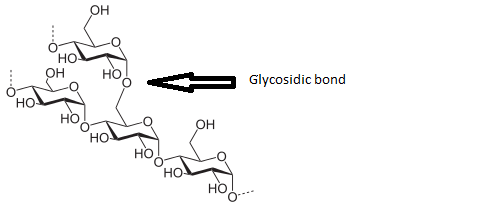
Figure 2: Structure of starch
After plants produce glucose by photosynthesis, it is stored in the cells as starch. Starch is insoluble in plant cell. So, unlike starch glucose increases the concentration of the plant cell.
(e)
Interpretation:
The most suitable matching pair of answers should be selected.
Concept introduction:
Sucrose is a disaccharide of Glucose and fructose, having twelve carbon atoms. Disaccharide consists of two monosaccharides, having six carbon atoms each.
Answer to Problem 23P
- a) Sucrose − transport form of carbohydrates
Explanation of Solution
Sucrose consists of a glucose molecule and a fructose molecule joined through a glycosidic bond.
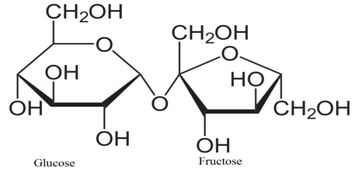
Figure 3: Structure of Sucrose
Plants store glucose (produced in photosynthesis) as starch in different places such as in fruits, seeds, and roots. Starch is insoluble in water and cannot be transported. When the plant needs energy, starch is converted to sucrose and transported. Even though glucose is soluble in water, plant does not convert starch to glucose. Since glucose is highly reactive compared to sucrose, it can transform into other intermediate compounds during transportation. Once it reaches the destination, sucrose is converted to glucose.
(f)
Interpretation:
The most suitable matching pair of answers should be selected.
Concept introduction:
Amylose is a polysaccharide made up of glucose units. These glucose molecules are bonded to each other through a (1→4) glycosidic bonds. Due to its tightly packed helical structure, amylose is resistant to digestive enzymes and therefore known as a resistant starch.
Answer to Problem 23P
- b) Amylose -
Explanation of Solution
As indicated in the figure, the first and fourth carbon of the glucose monomers react to form a bond between them. This bond is known as 1, 4 glycosidic bond.

Figure 4: Structure of amylose
(g)
Interpretation:
The most suitable matching pair of answers should be selected.
Concept introduction:
Amylopectin is a highly branched
Answer to Problem 23P
- c) Amylopectin − includes
Explanation of Solution
Amylopectin is a highly branched polymer. This is also known as polysaccharide. The primary unit is glucose. Like amylose, the glucose units are linked in a linear way with a (11→4) glycosidic bonds. This

Figure 5: Structure of amylopectin
(h)
Interpretation:
The most suitable matching pair of answers should be selected.
Concept introduction:
Photosynthesis is the process by which plants store energy of sunlight as chemical energy. Process happens in the chloroplast of a plant cell. Photosynthesis happens in two main stages - light reaction and dark reaction. The dark reaction consists either of the two
Answer to Problem 23P
- d) C3 plants − 3 − Phosphoglycerate is formed after carbon fixation
Explanation of Solution
The dark reaction of photosynthesis consists of two metabolic pathways, that is, C3 and C4 cycle. All the green plant uses one of these two pathways. The nomenclature is based on the number of carbon atoms present in the first metabolite produced after CO2 fixation.
The first metabolite produced in C3 cycle composed of three carbons while a four carbon metabolite is produced in C4 cycle.
The light reaction is common to both C3 and C4 cycle. But the type of enzymes and intermediate produced during the dark reaction are different.
RUBP (Ribulose Bisphosphate) carboxylase is the enzyme of C3 cycle which fixes CO2, present in the atmosphere. After Co2 fixation, a five-carbon molecule, RUBP (Ribulose bisphosphate) reacts with CO2 to form a six-carbon complex. The six-carbon molecule break immediately and form two 3- phosphoglycerate. 3- phosphoglycerate consists of three carbon atoms.
So, this is the first stable product of CO2 fixation. This is the reason why the mechanism is known as C3 cycle.
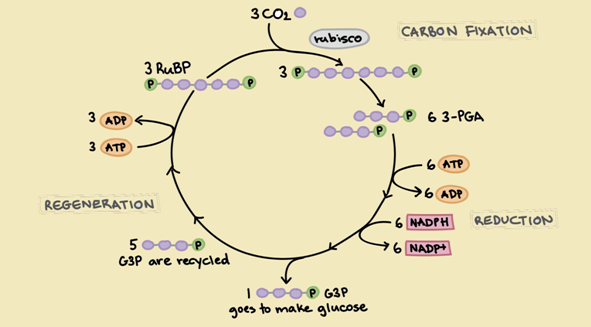
Figure 6: Calvin cycle of C3photosynthesis representing the carbon fixation.
(i)
Interpretation:
The most suitable matching pair of answers should be selected.
Concept introduction:
Photosynthesis is the process by which plants store energy of sunlight as chemical energy. Process happens in the chloroplast of a plant cell. Photosynthesis happens in two main stages - light reaction and dark reaction. The dark reaction consists either of the two metabolic pathways, that is, C3 and C4 cycle.
Answer to Problem 23P
- e) C4 plants − carbon fixation results in oxaloacetate formation
Explanation of Solution
The dark reaction of photosynthesis consists of two metabolic pathways, that is, C3 and C4 cycle. All the green plant uses one of these two pathways. The nomenclature is based on the number of carbon atoms present in the first metabolite produced after CO2 fixation.
As explained earlier, the first metabolite produced in C3 cycle composed of three carbons while a four-carbon metabolite is produced in C4 cycle.
Out of the two steps of photosynthesis (light and dark reaction), light reaction is common. But the type of enzymes and intermediate produced during the dark reaction are different.
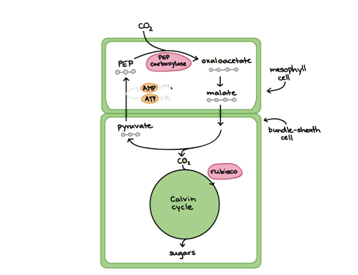
PEP (Phosphoenolpyruvate) carboxylase is the primary enzyme of C4 mechanism which catalyzes the fixation of CO2 in chloroplast. For this, a three-carbon molecule (PEP) reacts with CO2 to form a four-carbon molecule which is known as oxaloacetate. Oxaloacetate is the first stable product of C4 cycle.
This is the reason why the mechanism is called C4 mechanism. The reactions take place in mesophyll cells.
(j)
Interpretation:
The most suitable matching pair of answers should be selected.
Concept introduction:
Stomata are pores, found in the epidermis of leaves, stems, and other organs that facilitate gaseous exchange.
Answer to Problem 23P
- f) Stomata − allow exchange of gases
Explanation of Solution
Stomata are the pores which are mostly found in the epidermis of leaves and stems. It facilitates gaseous exchange. This stomatal pore is bordered by the guard cells which regulates the stomatal opening and closing.
Atmospheric air consists of carbon dioxide and oxygen enters the plant through these openings. These gases are crucial for photosynthesis and respiration, respectively. Also, water vapor releases to the atmosphere through the stomata. The process is known as transpiration.
So, stomata are the structures, present in the plant leaves crucial for all types of gaseous exchanges.
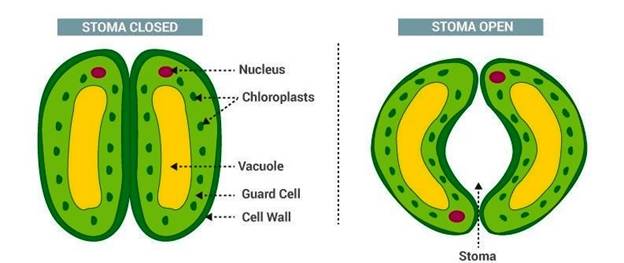
Figure 8: Microscopy view of stomata
Want to see more full solutions like this?
Chapter 20 Solutions
BIOCHEMISTRY 2 TERM ACCESS
- PLS ASNWER ALL. CHOOSE THE CORRECT LETTER 1.What is the mechanism of ATP synthesis in glycolysis?substrate level phosphorylationoxidative phosphorylationA. reductionB. oxidation 2.What is the net ATP yield of the complete glycolysis of 5 molecules of glucose?A.10B. 12C. 5 D.4arrow_forwardLong explanations are not needed. Direct answers would suffice. ***kind of in a hurry so having the answer asap would greatly be appreciated, thank you :)) a. The product formed in the first substrate-level phosphorylation reaction in glycolysis is ___________. i. 1,3-bisphosphoglycerate ii. 2-phosphoglycerate iii. phosphoenol pyruvate iv. 3-phosphoglycerate b. Polysaccharides are biomolecules with monomeric units linked via peptide bond. i. True ii. Falsearrow_forwardQuestion 5 Review Concept 10.4 Calvin Cycle. Match the term and its description. Each term can only be used once. G3P. ADP, NADP+ and Pi | Choose ) 9 ATP. 6 NADPH, 3 CO2 | Choose J Carbon fixation is catalyzed by this enzyme called | Choose ) This molecule is considered as CO2 acceptor. | Choose J >arrow_forward
- true or false 1. Phosphoenolpyruvate carboxykinase is the enzyme involved in the carbon dioxide fixation in the mesophyll cells of C4 plants 2. The C4 pathway utilizes less ATP than C3 pathway thus enabling C4 plants to adapt to tropical temperatures. 3. Photorespiration occurs when [O2]/[CO2] is high. 4. The carboxylase activity of RuBisCO catalyzes the fixation of carbon dioxide. 5. In cyclic photophosphorylation, only ATP is produced. 6. Chlorophyll has iron as the metal center of the porphyrin ring.arrow_forwardCHOOSE THE CORRECT LETTER ONLY. PLS ANSWER 1.What is the product of the reaction catalyzed by glucosephosphate isomerase?A.glyceraldehyde-3-phosphateB. glucose-6-phosphateC.fructose-6-phosphateD."fructose-1.6-bisphosphate" 2.Catabolic pathways generally aim to produce ATP and precursors of anabolic reactons.A. TrueB. Falsearrow_forwardSelect all that apply. Which of the following are coenzymes used in oxidation-reduction reactions? O FMN O FAD O NADP* O ATP NADarrow_forward
- Please choose the correct letter . and explain a bit why you choose it According to the second law of thermodynamics, a. energy will not be destroyed b. energy will not be created c. potential energy will always increase d. entropy will always increase e. both a and b are correct 2. In one of the reactions of the citric acid cycle, malate is oxidized to oxaloacetate. When this reaction is considered in isolation, a small amount of malate remains and is not oxidized. The best term to explain this is a. enthalpy b. entropy c. equilibrium d. free energy e. loss of energyarrow_forwardThe Calvin cycle begins when CO2 reacts with (a) phosphoenolpyruvate (b) glyceraldehyde-3-phosphate (c) ribulose bisphosphate (d) oxaloacetate (e) phosphoglyceratearrow_forward1. Enthalpy and Entropy. carbon dioxide and water into glucose (C6H1206) and oxygen according to the Photosynthesis in plants converts equation below. Calculate the change in enthalpy DHO and standard molar entropy OSD. Formula: AH° reaction = EH° products -EH° reactants AS° reaction = Es° products - ES° reactants %3D 6CO2 (R) + 6H20 m C6H1206 (s) + 602 (e) Substance CO2 (g) H20 (1) COH1206 (s) O2 (B) AH° (kJ/mol) AS (J/mol.K) -393.5 -285.8 -1273.3 213.6 69.9 209.2 209.2 Option 1 а. What is the OHO of the reaction? Your answer ts * b. What is the DSO of the reaction Your answerarrow_forward
- CHOOSE THE CORRECT LETTER ONLY. PLS ANSWER 1.Which of the following pathways DOES NOT occur in the mitochondria?A.Glycolysis B.Oxidative PhosphorylationC. Beta Oxidation of Fatty AcidsD.Krebs' Cycle 2.What defines the sum of all biochemical reactions of an organism?A.AnabolismB.MetabolismC.CatabolismD. Embolism 3.Oxidative phosphorylation happens in the mitochondriaA.TrueB. Falsearrow_forwardchoose correct letter and explain why you choose it 1.Which of the following terms is closest to our current understanding of enzyme function? a. Fluid mosaic model b. Induced fit model c. Lock and key model d. Cofactor e. Free energy 2. If a hypothetical chloroplast has only photosystem I, then the Calvin cycle a. can proceed as normal b. cannot proceed because only NADPH is produced c. cannot proceed because only ATP is produced d. cannot proceed because it depends on light e. cannot proceed because O2 cannot be produced from carbon dioxidearrow_forwardWorksheet on Computation of ATP yield from Fatty acid metabolism. Consider docosanoic acid, C21H43CO2H a. Label alpha (a) and beta ( B) carbons b. Draw the acyl COA derived from this fatty acid c. How many acetyl CoA molecules are formed by complete B-oxidation? d. How many cycles of B- oxidation are needed for complete oxidation? e. How many molecules of ATP are formed from the complex catabolism of this fatty acid.arrow_forward
 Biology (MindTap Course List)BiologyISBN:9781337392938Author:Eldra Solomon, Charles Martin, Diana W. Martin, Linda R. BergPublisher:Cengage Learning
Biology (MindTap Course List)BiologyISBN:9781337392938Author:Eldra Solomon, Charles Martin, Diana W. Martin, Linda R. BergPublisher:Cengage Learning
